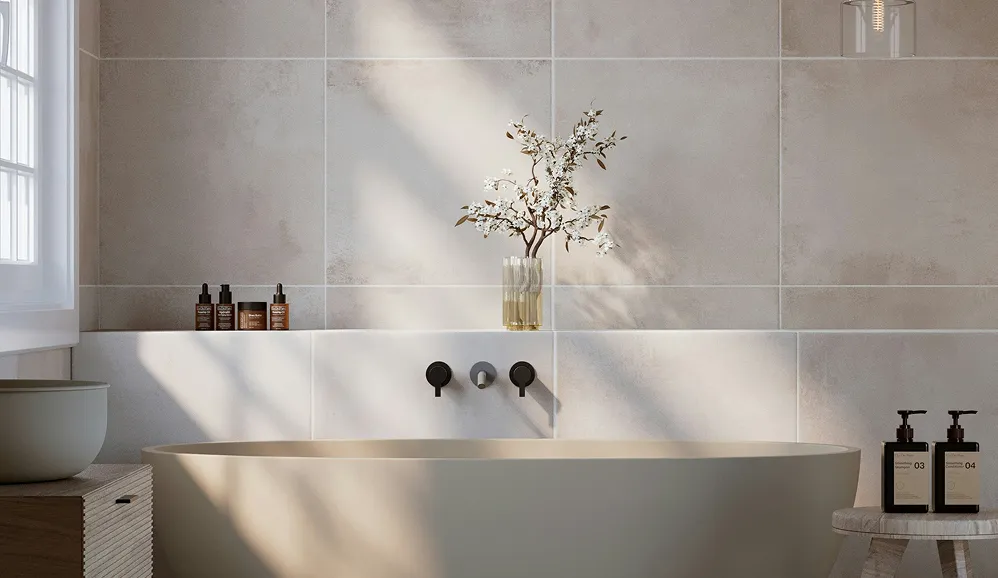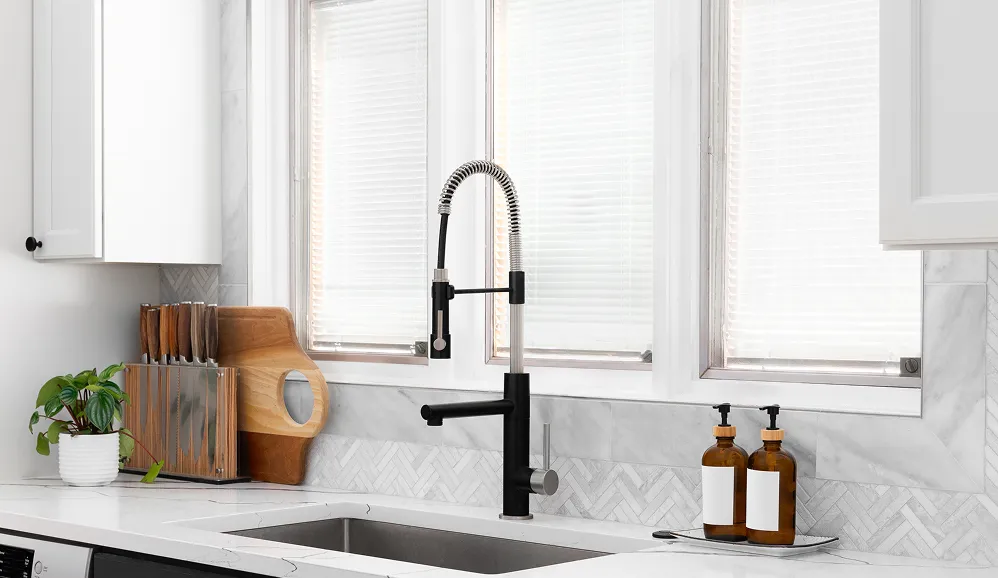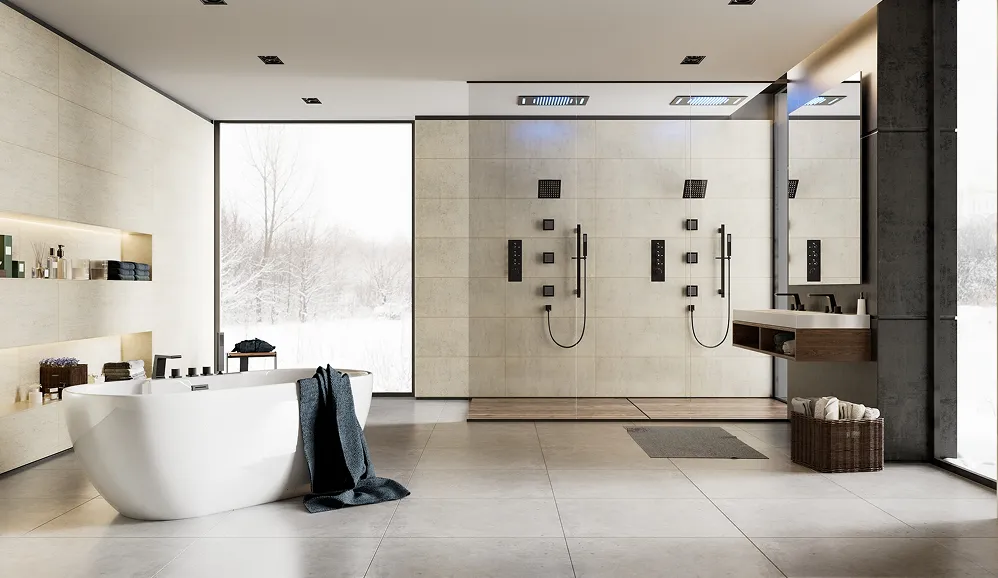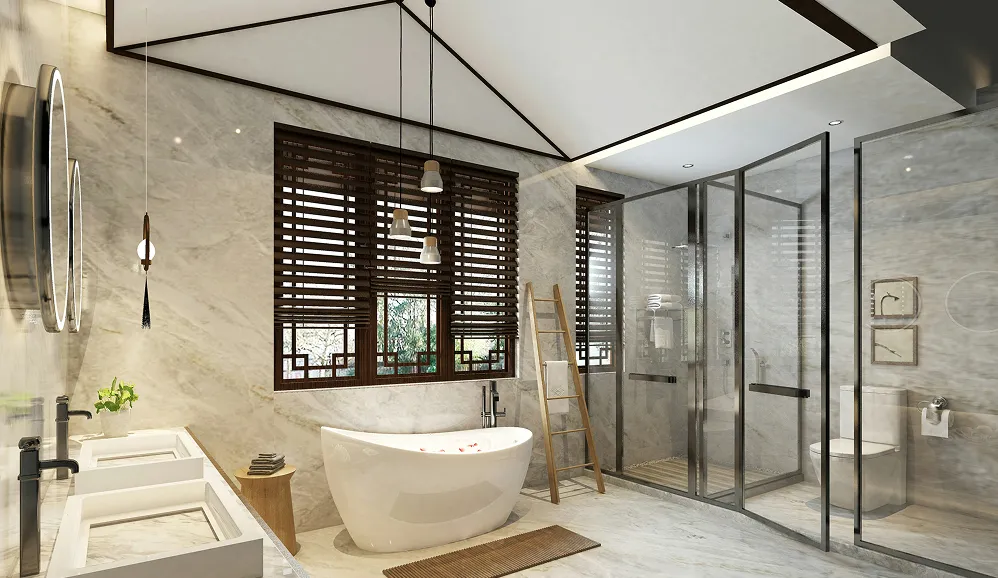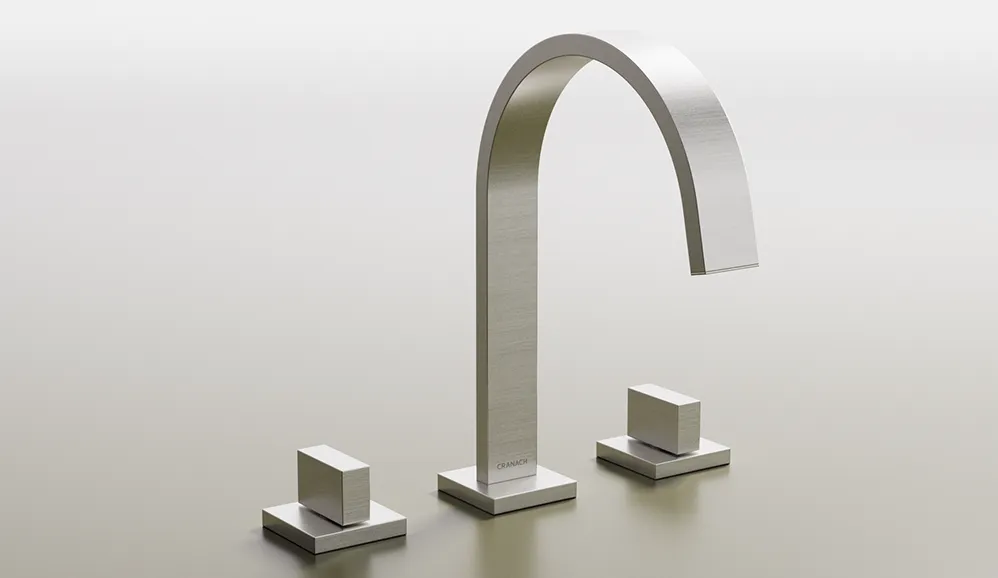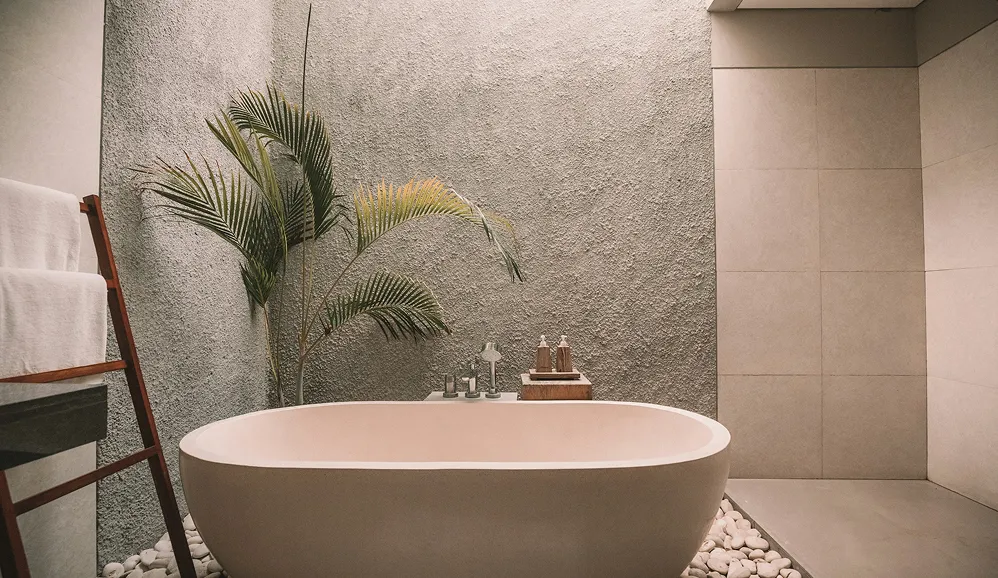Choosing a faucet might seem like a small detail in the grand scheme of a bathroom remodel, but it’s one of those finishing touches that truly anchors the entire space. It’s the kind of decision that sets the tone for your daily routine. This guide is here to walk you through the different types of bathroom faucets so you can pick the right one with confidence.
From the way the handles work to how the faucet actually mounts to your sink, getting a handle on these differences is the first real step to finding a fixture you’ll love for years to come.
Mapping Out Your Faucet Options
The path to the perfect faucet begins with understanding the core categories. Think of it like creating a blueprint for your bathroom. Before you can even think about the finish or style, you need to know what actually fits the foundation you’re working with—that is, the sink and plumbing you already have.
The global bathroom faucet market is now worth around $15 billion, and it’s no surprise that single-handle designs are leading the charge. They’re loved for their modern, clean look and how simple they are to use.
This image breaks down the main handle configurations you’ll come across.
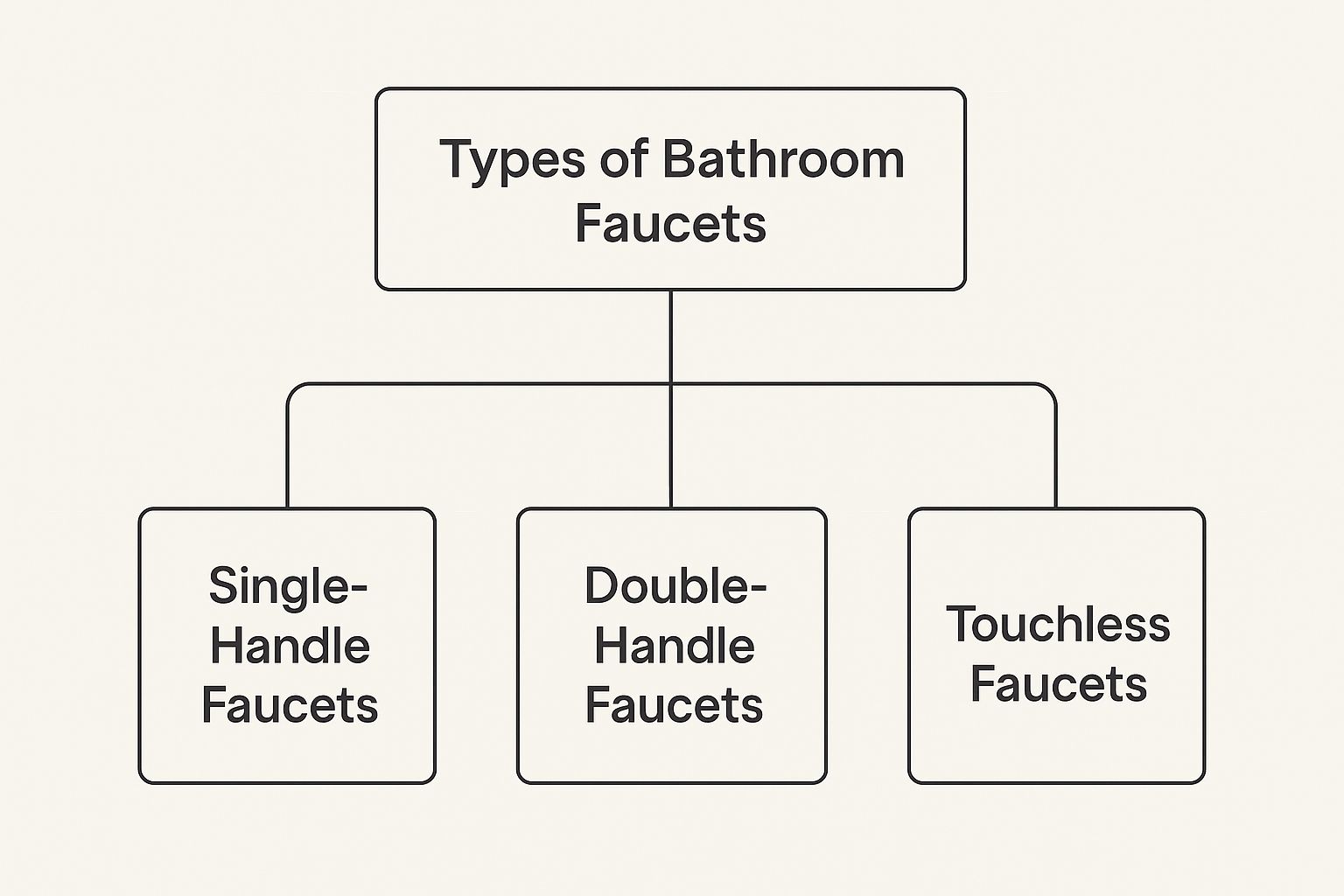
As you can see, one of the first things you’ll decide is how you want to control the water flow and temperature. This single choice dramatically narrows down your options and points you in the right style direction.
Key Faucet Categories to Know
The main types of bathroom faucets are really defined by two things: how they are installed and what kind of handle they have. Nailing this part of the decision ensures your new faucet will not only be compatible with your setup but will also look seamless and intentional.
Here are the foundational types you’ll run into:
- Mounting Style: This is all about where the faucet is installed. Does it sit on the sink or countertop (deck-mount), or does it come out from the wall behind the sink (wall-mount)?
- Handle Configuration: This covers how you turn the water on and adjust the temperature. You’ll find single-handle, double-handle, and even touchless (sensor-activated) models.
- Hole Configuration: This is probably the most important technical detail. It refers to the number of pre-drilled holes in your sink or countertop, like single-hole or three-hole setups.
Getting these three elements right from the start is absolutely crucial. You could find the most beautiful widespread faucet in the world, but it simply won’t work if your sink only has a single hole. Likewise, a deck-mounted model is a non-starter if your plumbing is configured for a wall-mount.
CRANACH offers a complete lineup of bathroom sink faucets designed to fit just about any of these configurations. And once you have your faucet picked out, you can get more great ideas by checking out these tips for building a luxurious bathroom. For a deeper dive, our complete guide on how to choose a bathroom faucet is the perfect next step.
Deck-Mounted Faucets: The Classic Choice for Your Countertop
When you picture a bathroom faucet, you’re probably thinking of a deck-mounted one. These are the most common faucets you’ll find, installed directly onto the flat surface—or “deck”—of the sink or countertop. Their widespread appeal comes from a simple formula: they’re versatile, familiar, and generally straightforward to install, making them a reliable go-to for most bathroom projects.
But “deck-mounted” isn’t a single style. It’s more like an umbrella category that covers three distinct variations, each designed for different sink setups and design goals. Getting to know these sub-types is the key to matching the right faucet to your plumbing and vision. And it’s a big deal, considering bathroom sink faucets make up roughly 63.57% of total faucet sales. That massive market share, as highlighted by Maia Research, shows just how much homeowners value having a wide array of design choices.
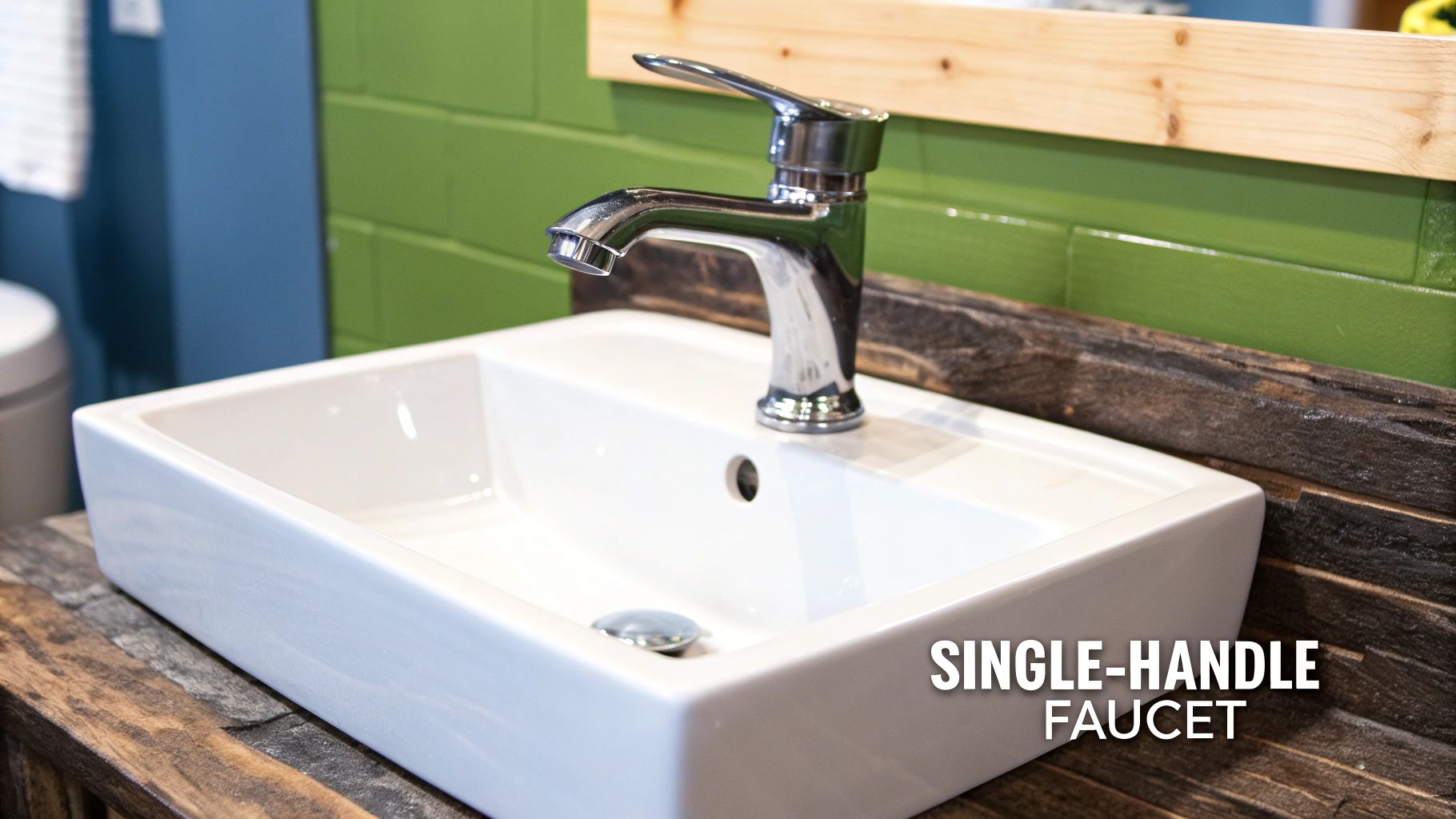
Single-Hole Faucets: The Minimalist Solution
True to their name, single-hole faucets pack everything into one sleek unit that requires just a single hole in your sink or counter. The spout and handle—often a single, clean-lined lever—are combined, creating a streamlined look that feels right at home in modern bathrooms or on smaller vanities where every inch counts.
Their greatest strength is their simplicity. Fewer parts mean a quicker, less complicated installation. If you’re aiming for that clean, uncluttered aesthetic, CRANACH has a beautiful selection of single-hole faucets that perfectly capture minimalist design. What if you love the look but your sink has three holes? No problem. Just use a deck plate (also called an escutcheon) to cover the extra openings for a clean, seamless finish.
Widespread Faucets: The Customizable Choice
If you’re looking for a more high-end, custom feel, a widespread faucet is a fantastic choice. This style comes in three completely separate pieces: a spout and two independent handles. This setup gives you the freedom to space them out as you see fit, typically anywhere from 8 to 16 inches apart.
That separation creates an elegant, built-in appearance that works beautifully on larger vanities, especially in master bathrooms. The installation is a bit more involved than a centerset since each piece needs to be installed and connected under the counter. But the final result is a sophisticated, spacious look that adds a real touch of luxury to the room.
Wall-Mount Faucets For A Modern Look
If you’re looking for a design choice that truly elevates a bathroom from standard to statement, look no further than the wall-mount faucet. These fixtures are a game-changer. Instead of sitting on the sink deck or countertop, they emerge directly from the wall, creating a stunning, architectural look that instantly signals a custom, high-end space.
This is one of the best types of bathroom faucets for achieving that clean, almost minimalist feel. By lifting all the hardware off the counter, you free up so much valuable surface area. The result is a sleek, uncluttered vanity that’s incredibly easy to wipe down—no more trying to clean around a clunky faucet base.
This beautiful bathroom featured in a leading design magazine is the perfect example. See how the wall-mount faucets contribute to that clean, spa-like atmosphere? The design lets the gorgeous vessel sinks and textured wall be the stars of the show.
Specialty Faucets For Statement Sinks
Sometimes, your bathroom design calls for something more than the usual deck or wall-mounted faucet. When you’re working with a unique sink, you need a fixture that not only fits but makes a bold statement. These specialty types of bathroom faucets are the showstoppers, turning a purely functional item into a piece of art.
If you’re aiming for a high-end, custom look, this is where the real fun begins. It’s a growing corner of the market, too. Driven by a love for unique design and smart home features, even these specialty faucets are getting more advanced. We’re seeing everything from precise temperature control to touch-free operation, proving you don’t have to sacrifice function for jaw-dropping style. This trend is part of a larger global push, which you can read about in industry analyses from sources like Grand View Research.
Essential Factors To Consider Before Buying
Choosing from all the different types of bathroom faucets is the fun part, but let’s be honest—the perfect fixture is more than just a pretty face. It has to fit, last, and work efficiently. Before you fall in love with a specific design, this practical checklist will walk you through the technical details that matter most.
The first, most important step? Confirm your sink’s hole configuration. This isn’t just a suggestion; it’s the rule that dictates which faucets will even fit. Measure the distance between the center of the outermost holes to know if you need a centerset (a 4-inch spread) or widespread (an 8-inch or more spread) faucet.
Valve Technology: The Heart Of Your Faucet
Beneath that polished exterior lies the faucet’s valve, the little engine that controls water flow and temperature. This is where long-term reliability is truly decided. Over the years, the industry has wisely shifted toward one superior technology for its leak-free performance.
The gold standard in modern faucets is the ceramic disc valve. It uses two highly polished ceramic discs that slide against each other, creating a nearly perfect, long-lasting seal. This design resists wear and tear far better than the old rubber washer or ball valve systems ever could.
Choosing The Right Finish For Durability And Style
The finish does more than just define the faucet’s look; it also determines its durability and how much time you’ll spend cleaning it. Your choice should balance your bathroom’s vibe with your tolerance for daily maintenance.
- Polished Chrome: Timeless, incredibly durable, and easy to match with other fixtures. Its one downside? It loves to show off fingerprints and water spots.
- Brushed Nickel: A contemporary favorite for a reason. It excels at hiding smudges and water marks, making it a fantastic low-maintenance option.
- Matte Black: This finish makes a bold, modern statement that instantly stands out. It’s a striking choice, but it can show dust and hard water buildup more readily than other finishes.
Think about how the finish will coordinate with other hardware in your bathroom, like towel bars and cabinet pulls, to create a look that feels intentional and cohesive.
Water Efficiency And Modern Innovations
A great faucet shouldn’t just look good; it should be efficient, too. Keep an eye out for the WaterSense label, a program from the U.S. Environmental Protection Agency. This label certifies that a faucet uses at least 20% less water than the standard, all without sacrificing performance. It’s an easy way to save your household hundreds of gallons of water each year.
Before you make your final decision, it’s always a good idea to run through a quick checklist. This helps ensure the faucet you’re eyeing ticks all the right boxes—from how it looks to how it functions.
Your Faucet Feature Checklist
Use this checklist to ensure your chosen faucet meets all your functional, technical, and design requirements before you commit.
| Feature | What To Check | Why It Matters |
|---|---|---|
| Sink Compatibility | Number of holes and spread measurement (e.g., 4″ or 8″). | This is the most crucial fit factor. The wrong configuration simply won’t install. |
| Valve Type | Look for ceramic disc valves. | Ensures a long, leak-free life and smooth handle operation. Avoid older rubber washer types. |
| Finish | Durability, maintenance needs, and style coordination. | The finish impacts both the look and how often you’ll need to clean it. |
| Water Efficiency | Check for the WaterSense label. | Saves water and money without compromising on water pressure. |
| Spout Height & Reach | Does it clear the sink bowl and direct water properly? | An ill-fitting spout can cause splashing or be awkward to use. |
| Warranty | Look for a limited lifetime warranty. | Protects your investment against defects and shows the brand stands behind its product. |
Answering Your Top Faucet Questions
Jumping into the world of bathroom fixtures can definitely stir up a few questions. To make sure you feel totally confident before making a final decision, we’ve put together some clear, no-nonsense answers to the questions we hear most often from homeowners looking at different types of bathroom faucets.
What Is The Difference Between Centerset And Widespread Faucets?
The real difference between these two super popular styles comes down to their construction and what kind of sink they fit. You can think of it like a pre-packaged meal versus buying individual ingredients.
A centerset faucet is an all-in-one unit. The spout and handles are all connected on a single base plate, made specifically for sinks with three holes where the two outer holes are 4 inches apart from center to center. It’s a classic, bundled solution.
A widespread faucet, on the other hand, is made of three totally separate pieces: a spout and two handles. This gives you much more flexibility, working with hole spacings anywhere from 8 to 16 inches. It creates a more expansive, custom look that feels right at home on larger vanities. Ultimately, the choice is made for you by the holes already drilled in your sink or countertop.
Can I Install A Single-Hole Faucet On A Three-Hole Sink?
Yes, you absolutely can! It’s a common situation and an easy fix. While you can’t put a three-hole faucet on a single-hole sink, going the other way around is pretty straightforward.
To fit a sleek, modern single-hole faucet onto a sink drilled for a three-hole setup, you’ll just need a deck plate (sometimes called an escutcheon). This is a slim base plate that neatly covers the two unused outer holes, giving you a clean, seamless look.
How Do I Pick The Best Faucet Finish For My Bathroom?
Choosing the right finish for your bathroom sink faucets is really a balancing act between your personal taste, how much cleaning you’re willing to do, and the other hardware in the room. Every finish brings its own personality and practical points to the table.
Here’s a quick look at the most popular options:
- Polished Chrome: A true classic. It’s incredibly durable and a breeze to match with other fixtures and accessories.
- Brushed Nickel: This contemporary finish has a softer, warmer look and is fantastic at hiding fingerprints and water spots, making it a low-maintenance favorite for busy households.
- Matte Black: If you want to make a bold, modern statement, nothing beats matte black. Just know that it can show dust a bit more readily than other finishes.
- Oil-Rubbed Bronze: This finish offers a warm, traditional feel that brings a touch of classic elegance to any bathroom.
The right finish truly ties the whole room together. To keep it looking brand new, a little regular care goes a long way. For some expert tips, you can learn more about the proper techniques for cleaning bathroom faucets to maintain their beauty for years to come.
Are Wall-Mount Faucets Difficult To Install?
I won’t sugarcoat it—wall-mount faucets are more complex to install than their deck-mounted cousins. But the jaw-dropping result is often worth the extra effort. The challenge comes from the fact that all the important plumbing, including the faucet’s main valve (the “rough-in valve”), has to be installed inside the wall.
This means the work needs to happen before the drywall and tile go up. That’s why wall-mount faucets are a much better fit for new construction or a major gut-job renovation where the walls are already open. While the installation demands some serious planning and usually a professional’s touch, the payoff is huge: a completely clear countertop and a striking, high-end look that’s tough to get with other types of bathroom faucets.
Ready to find the perfect fixture that marries flawless function with beautiful design? Explore the full collection of CRANACH bathroom sink faucets and discover a model that will truly elevate your space.
Browse Our Faucet Collection

